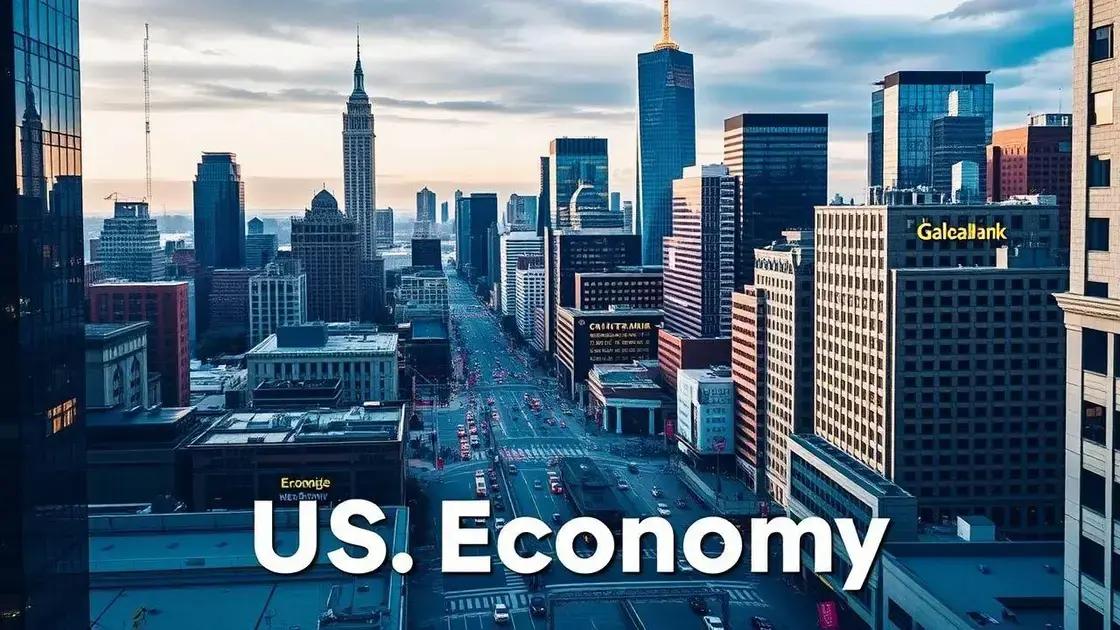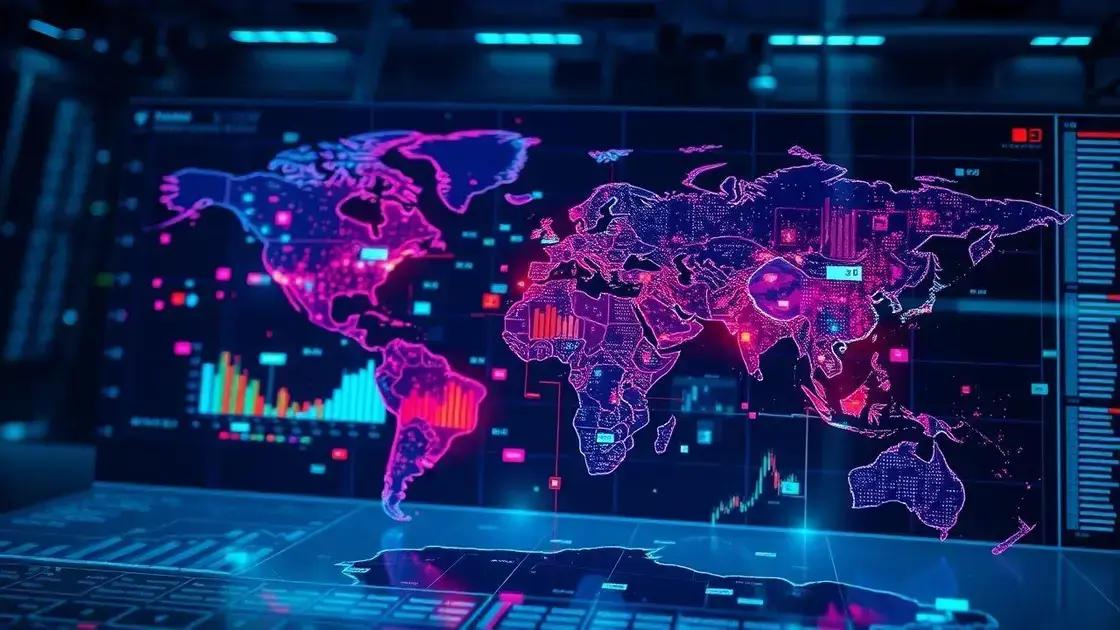US economy trends that everyone should be aware of

The future of the US economy will be shaped by inflation, job market trends, and government policies, influencing growth rates and overall economic health.
When we talk about the US economy, it’s clear that its dynamics can influence not just Americans but people around the world. So, what are the key trends shaping it right now?
Current state of the US economy
The current state of the US economy reflects a complex interplay of factors that impact everyday life for citizens. Understanding these dynamics can help individuals navigate financial decisions more effectively.
Economic Growth Rates
Economic growth in the US has experienced fluctuations recently. Factors such as consumer spending, investment, and exports play crucial roles in determining growth rates. Generally, growth can indicate a healthy economy; however, it can also mean inflationary pressures.
Inflation Rates
Inflation is a vital indicator to keep an eye on. Rising prices affect purchasing power, making it important for consumers to adapt. Here’s why monitoring inflation is crucial:
- Increased living costs can strain household budgets.
- Higher inflation can lead to tighter monetary policies.
- Savings may lose value over time if not invested wisely.
As inflation rises, the US economy faces challenges. Central banks often adjust interest rates to manage inflation—this can impact loans and mortgages directly.
Additionally, the job market showcases a mixed picture. While unemployment rates might drop, the quality of jobs available can vary widely. Job types in demand often shift depending on changes in technology and consumer needs.
The Role of Government Policy
Government policies also significantly influence the economy. Fiscal measures, like stimulus packages, can invigorate economic activity, while tax policies can shape business investments.
In conclusion, keeping up with the current state of the US economy is essential. By understanding growth rates, inflation, job market conditions, and policies, consumers can make informed decisions that benefit their financial well-being.
Inflation and its effects on consumers
Inflation has become a significant factor in the lives of consumers today. As prices rise on everyday goods and services, many people feel the pinch in their budgets. This increase can alter spending habits and affect overall quality of life.
Understanding Inflation
Inflation refers to the general rise in prices, which can erode purchasing power. When inflation is high, consumers may struggle to keep up with the costs of essentials like food, housing, and transportation. It’s crucial to grasp how inflation impacts finances.
Types of Inflation
There are two main types of inflation:
- Demand-pull inflation: This occurs when demand exceeds supply.
- Cost-push inflation: This happens when the cost of production increases, leading to higher prices for consumers.
Both types of inflation can significantly influence consumer behavior.
For example, during times of rising prices, many individuals cut back on discretionary spending. Families may dine out less often or delay purchasing non-essential items. This shift in consumer habits can, in turn, impact businesses and the economy as a whole.
Effects on Household Budgets
As inflation continues to rise, it affects household budgets in various ways. For instance, families might spend a larger percentage of their income on basic necessities. This could lead to reduced savings or limit funds available for emergencies or future investments.
Understanding these pressures is critical for consumers. By being aware of economic trends, individuals can make informed financial decisions, such as adjusting their budgets or looking for cost-effective alternatives. The impact of inflation on daily life calls for a proactive approach to managing finances.
Impact of government policies on growth

The impact of government policies on growth is significant and can shape entire economies. Policies related to taxation, spending, and regulation play crucial roles in influencing economic performance.
Taxation Policies
Tax policies can either stimulate or hinder economic growth. Lower tax rates can encourage businesses to invest and expand. This often leads to increased job creation and higher wages. Conversely, higher taxes might restrict spending and investment, stalling growth. Understanding how tax rates affect behavior helps consumers and businesses plan effectively.
Government Spending
Government spending directly affects growth by influencing demand in the economy. For instance, investments in infrastructure can create jobs and enhance productivity. This leads to long-term benefits for the economy:
- Improved transportation can reduce costs for businesses.
- Construction projects create immediate job opportunities.
- Public health initiatives can increase the overall productivity of the workforce.
Such spending encourages both consumer confidence and business investment, resulting in positive growth trajectories.
Regulatory Frameworks
The regulatory environment can also influence economic growth. Regulations protect consumers and the environment but can also create challenges for businesses. Striking the right balance is key. Increasing regulations may slow down business activities, while too few regulations might lead to market failures.
For example, a well-designed regulatory framework encourages innovation, while an overly restrictive one can stifle it. The effectiveness of government policies in promoting a healthy growth environment hinges on this balance.
In summary, the relationship between government policies and economic growth is complex. By understanding taxation, spending, and regulations, one can see how intertwined these elements are with the overall health of the economy. Continued adjustments in policies aim to foster sustainable growth, though the effectiveness can vary greatly.
Job market trends in the US
The job market trends in the US reflect ongoing changes influenced by various factors like technology, demographics, and economic policies. Understanding these trends is essential for job seekers and employers alike.
Shift Towards Technology Jobs
As technology rapidly evolves, many traditional jobs are being replaced or transformed. This shift leads to an increased demand for tech-related positions such as software developers, data analysts, and digital marketers. Those with skills in technology often find better job prospects and higher salaries in the current market.
Growing Gig Economy
The gig economy is another trend that continues to gain momentum. Many people are opting for freelance work or short-term contracts instead of traditional full-time jobs. This change offers flexibility and independence but also comes with challenges. Here are some key aspects of the gig economy:
- Increased flexibility in work hours.
- Variety of job opportunities across different industries.
- Less job security compared to full-time positions.
The gig economy reflects a significant shift in how people view work, emphasizing autonomy and entrepreneurship.
Demographic Changes
Demographic trends also influence the job market. For instance, as baby boomers retire, younger generations must fill these gaps. This shift can lead to a shortage of skilled workers in certain industries, creating more opportunities for younger job seekers. Companies are focusing on attracting and retaining talent by offering better benefits and work environments.
Moreover, remote work has become increasingly common. Many companies now offer flexible work arrangements to accommodate a diverse workforce. This trend allows employees to work from different locations, impacting how businesses operate.
In summary, understanding the current job market trends in the US is crucial for anyone navigating their career path. Whether you are entering the workforce or looking to make a change, being aware of these trends will help you make informed decisions about your future.
Future projections for the US economy
Future projections for the US economy involve various predictions based on current trends, data analysis, and expert insights. Understanding what lies ahead can help individuals and businesses prepare accordingly.
Economic Growth Forecasts
Experts predict varying growth rates over the next few years. Factors such as consumer spending, government policies, and international trade will shape overall growth. Analysts often project modest growth, influenced by inflation and potential recessions.
Inflation Trends
Inflation is expected to remain a significant concern going forward. If inflation continues to rise, it could impact purchasing power and savings. Here are some potential outcomes:
- Increased costs of goods and services can squeeze household budgets.
- High inflation may force the Federal Reserve to raise interest rates.
- Inflation can lead to changes in consumer behavior, such as reduced spending on non-essential items.
As these factors play out, consumers and businesses must adapt to a changing financial landscape.
Job Market Outlook
The job market is another area to watch closely. Projections suggest continued growth in sectors like technology and healthcare while traditional industries may face challenges. Companies will likely need to invest in workforce development, focusing on skills that match future job requirements. This shift emphasizes the importance of education and training for workers.
The rise of automation and artificial intelligence is set to reshape many roles. While some jobs may disappear, others will emerge, creating opportunities for innovation. Workers must stay informed to navigate these changes effectively.
In terms of investments, sectors such as renewable energy and technology provide exciting prospects. With government initiatives promoting sustainability, many businesses are leaning towards greener practices. These changes can foster economic growth while addressing environmental concerns.
In conclusion, the future projections for the US economy hinge on a combination of growth factors, inflation, and shifts in the job market. Staying informed and adaptable will be essential for both individuals and businesses as they navigate the evolving economic landscape.
In summary, the future of the US economy is affected by growth, inflation, and job market trends. Understanding these aspects is crucial for making informed decisions. By staying aware of how policies impact the economy, individuals and businesses can adapt and thrive in changing environments. As new opportunities arise, embracing technology and innovation will be key to success.
FAQ – Frequently Asked Questions about the US Economy
What are the current trends in the US job market?
The US job market is seeing growth in technology and gig economy jobs, while traditional roles may face challenges.
How does inflation impact consumers?
Inflation can lead to rising prices, affecting purchasing power and prompting changes in consumer spending habits.
What should businesses focus on for future growth?
Businesses should pay attention to investing in technology, renewable energy, and adapting to changing labor demands.
How volatile is the future of the US economy?
The future of the US economy is uncertain but will be influenced by factors like inflation, policy changes, and global market conditions.






